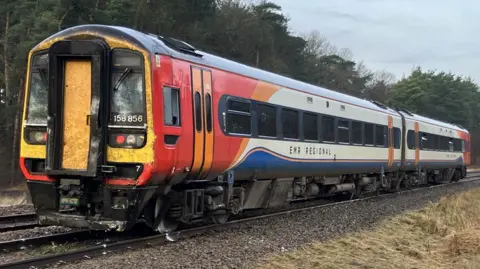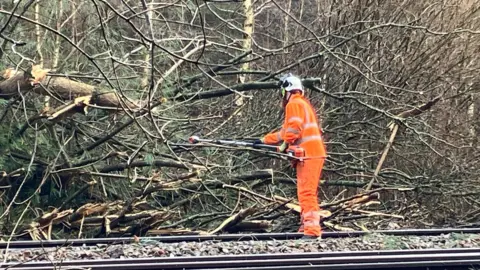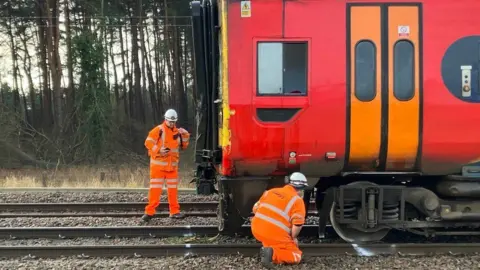Tree management warning after train derailment
 Andrew Sinclair/BBC
Andrew Sinclair/BBCForestry England and Network Rail have been told to review the way they manage trees near railways after a train was derailed by two that had fallen on to a line.
An East Midlands Railway service carrying 31 passengers partially came off the tracks at Roudham Heath, near Thetford, Norfolk, on 6 February last year while travelling at 83mph (134km/h).
The Rail Accident Investigation Branch (RAIB) found "the risk imposed by trees standing in saturated soil was not being effectively managed" by the organisations, which was "an underlying factor to this accident".
Network Rail said it was working to "minimise the risk of similar incidents" occurring.
Police, fire and ambulance crews were called to the scene of the crash at just after 20:50 GMT.
After striking the fallen trees, the train - heading towards Norwich - derailed and travelled for about 680m (2,230ft) before coming to a stop.
One of the passengers suffered a minor injury and no staff were hurt.
The incident led to the line being closed for the rest of the day while repairs took place.
 Andrew Sinclair/BBC
Andrew Sinclair/BBCThe investigation by the RAIB found after heavy rain the trees had become unstable in the sandy soil.
It was discovered a twin-stemmed pine tree fell first before striking an oak tree.
Its report said: "The pine tree suffered from a loss of root anchorage, primarily because it was standing in highly saturated, sandy soil.
"Because of the way the pine tree had grown and its proximity to the railway, it was more likely to land over the tracks in the event of it falling."
The RAIB said previous inspections of the trees by Network Rail and Forestry England had not identified any cause for concern.
It has since asked "the respective organisations to review their processes for inspecting and managing trees that are within falling distance of the railway, to consider the effects of high soil saturation levels on the risk of trees falling, and to make any appropriate changes".
 Andrew Sinclair/BBC
Andrew Sinclair/BBCMark Walker, route infrastructure engineer at Network Rail Anglia, said contractors and landowners had been working on a plan of action to "minimise the risk of similar incidents happening in future".
He said: "Arrangements are being put in place across the rest of the Anglia railway network to target only those trees that pose a risk of falling on to the railway, whilst being environmentally responsible and aware of the sensitivities of removing trees in the communities we serve."
A Forestry England spokesperson, said: "We are pleased that the report acknowledges our professionalism and that we had carried out the correct tree safety inspection the year before.
"We look after a lot of trees next to railways and remove trees that clearly pose a higher risk. No tree can be guaranteed to remain standing in all weather conditions and it can be very difficult, often impossible, to identify which, if any, might subsequently fall.
"We note the report's recommendation and will review our inspection guidelines for trees that are within falling distance of the railway with regards to high soil saturation levels."
Follow Norfolk news on BBC Sounds, Facebook, Instagram and X.
